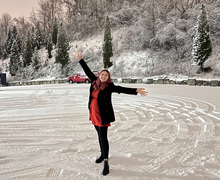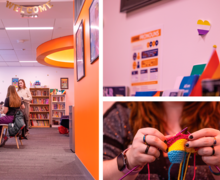University launches website to fight bias
Every so often, Kelly Emmons hears people using gay slurs.
‘Sometimes people say it so carelessly without realizing the effects,’ said Emmons, a junior history major.
Although Emmons said she thinks acts of bias on campus do not occur regularly, she knows they exist.
To inform the Syracuse University community about bias, the Inclusion, Community and Citizenship portfolio of the Division of Student Affairs launched the STOP Bias website in early September. In addition to providing information about bias and how to spot it, the website offers a reporting tool that allows SU students, faculty and staff to report bias-related incidents.
‘We’re trying to really lower the tolerance for even the smallest of bias attacks,’ said Rebecca Reed Kantrowitz, associate vice president for Inclusion, Community and Citizenship.
The ‘STOP’ in ‘STOP Bias’ stands for ‘Spot it. Talk about it. Open your mind. Prevent it.’ These are the steps people can take to eliminate acts of bias in the community, according to the STOP Bias website.
Bias is considered treating someone negatively based on his or her age, creed, disability, ethnicity, gender, marital status, political or social affiliation, race, religion or sexual orientation, according to the website. Examples of bias include telling jokes, name-calling, stereotyping, offensive graffiti, or avoiding or excluding others, according to the website.
The highest amount of bias occurs during the first six weeks of school because first-year students are not aware of what constitutes bias, Kantrowitz said.
‘Some people don’t realize that writing the word ‘fag’ is not OK to do on the white board in a residence hall,’ she said.
The STOP Bias website aims to help people become more aware of bias on the SU campus, Kantrowitz said. Although the website is still being fine-tuned, there is potential for it to grow, she said.
‘Right now, I think it’s basic, and it’s getting us started to get the word out there,’ Kantrowitz said.
SU students, faculty and staff who experience bias or see it happening can use the Bias Incident Reporting Form on the website to report acts of bias. Although the form has been available online for several years, improvements have been made to make it easier for people to use, such as making it shorter, Kantrowitz said.
The form, which may be submitted anonymously, asks for the reporting person’s contact information and details about the incident being reported. The form is not meant for events presenting immediate threat, which should be reported to the Department of Public Safety instead, Kantrowitz said.
‘Generally after we receive it, we will reach out in the next few days to see how the situation is resolved and how the student is doing,’ Kantrowitz said. ‘We don’t want people using this tool for emergencies.’
The information collected from the forms will provide insight as to how often bias-related incidents occur on campus, where they occur and for what reason they occur, she said.
Kantrowitz said more students may report bias-related incidents via the Bias Incident Reporting Form after they use the website and learn what constitutes bias. So if more incidents are reported this year than in previous years, it does not necessarily mean there is an increase of bias-related acts on campus.
‘It will be unclear if there’s more bias-related incidents or if more people are stepping up and noticing it,’ she said.
Allie Hootnick, a graduate student in the S.I. Newhouse School of Public Communications, said the STOP Bias website could help to create a positive environment on campus.
‘As long as people use it constructively, I think it will be something good to have,’ Hootnick said.
Emmons, the junior history major, also said she thinks the website will be beneficial for students.
‘It would be helpful for people to find information in one source, especially something that is relevant toward Syracuse University and geared toward Syracuse University,’ she said.
Kantrowitz said first-year students were already introduced to the STOP Bias website during Freshman Orientation. A poster campaign with testimonies from students about bias-related incidents will come out later in the semester, she said.
‘I think as our campus continues to become more diverse and people are continuing to think about what it’s like in a world where there may be different norms and different standards,’ Kantrowitz said, ‘it’s important that we try to make this an open community.’
Find the website at stopbias.syr.edu.
Published on September 29, 2010 at 12:00 pm





